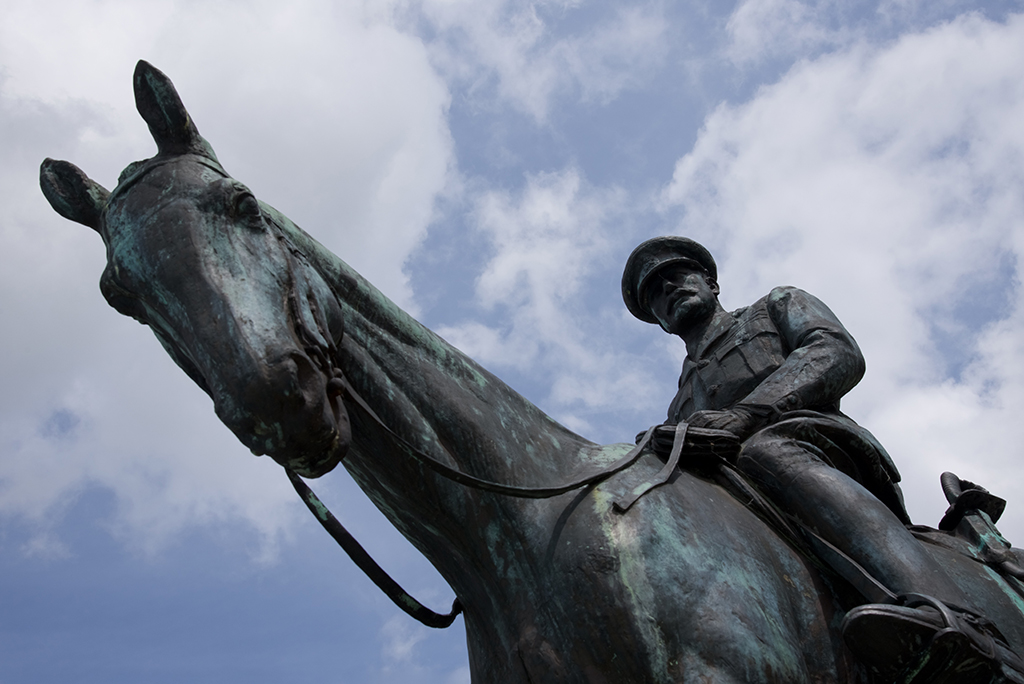Virtually all Wellington’s generals were Scots and almost 50 Victoria Crosses have been won by Scots.
Martial prowess is in the blood – so here’s our top ten of home-grown warriors
1. William Wallace
The most iconic Scottish soldier of all, Sir William Wallace was a knight who became one of the first leaders of the Wars of Scottish Independence 700 years ago. He famously led the Scots to victory over a larger and technologically superior English army at the Battle of Stirling Bridge in 1297, then became Guardian of Scotland until his defeat at the Battle of Falkirk in 1305. Wallace was then captured, handed to the English king, Edward Longshanks, and hung, drawn and quartered for high treason.
2. Major General Sir Hector MacDonald
A Gaelic-speaking crofter’s son from the Black Isle, ‘Fighting Mac’ enlisted at 17 as a trooper and ended as a Major General. Famous for his bravery, he fought in Afghanistan and won a DSO in 1891. He became a household name and was made a Colonel for his bravery at the Battle of Omdurman in 1898. Knighted in 1901 for his part in the Boer War, he shot himself in 1903 after a scandal; 30,000 Scots turned up at his funeral in Edinburgh
3. Lieutenant General Sir John Moore
Moore first saw action during the American War of Independence where he distinguished himself in the Penobscot Expedition, as part of a small British unit that held off a far larger American force until reinforcements arrived. Moore furthered his reputation in Ireland, when in 1798 he helped to suppress the republican rebellion, but his greatest achievement was a training regime that produced the first permanent light infantry regiments in Britain. Moore died after being fatally wounded at the Battle of Corunna against Napoleon in 1809.
4. Major General Douglas Wimberley
Wimberley was an offi cer on the Western Front during the First World War and made his name as commander of the 51st (Highland) Division in the Middle East, most notably at the Second Battle of El Alamein in World War II. He is renowned for instilling in his troops a sense of unity and willing to fi ght. One of his methods for accomplishing this was to have as many Scottish soldiers as possible, who he encouraged to wear their respective tartans, hence his moniker, ‘Tartan Tam’. In 1942 he was awarded a DSO for his actions.
5. 1st Earl of Leven
Alexander Leslie, 1st Earl of Leven, began his military career in the Dutch army and transferred to the Swedish army where he served with distinction and was knighted by the Swedish King. He returned to Scotland in 1638 as Lord General in Command of the Covenanting army and quickly developed a reputation for his tactical skills. He took Edinburgh Castle, for example, without the loss of any life. He conducted brilliant campaigns in the Bishop’s Wars and for the Solemn League and Covenant, and was still in command and conducting campaigns at seventy years of age.
6. Field Marshal Douglas Haig

A statue of Field Marshal Haig (Photo: M G White /Shutterstock)
Opinion is divided on Haig’s martial qualities. For many ‘Butcher Haig’ was the donkey whose criminally unimaginative leadership led to the slaughter of almost two million British lions at Ypres, Passchendaele and the Somme, where the British army sustained the highest casualties in its history. Yet US General John Pershing lauded Haig as ‘the man who won the war’ through tactics that were unavoidable and eventually forced the Germans to surrender, avoiding further bloodshed. At the time of his state funeral in 1928 he was widely seen as a great general to rank alongside Wellington
7. First Marquess of Montrose
James Graham, 1st Marquess of Montrose, aka ‘Great Montrose’, made his name as the Covenanter general who, in 1638, captured the Marquess of Huntly and whose attack on the Royalists at the Bridge of Dee led to the Treaty of Berwick. It was as a Royalist, however, that the swashbuckling Montrose had his greatest military successes, his Highland army defeating the covenanters in six battles, culminating in the great Battle of Kilsyth in 1645, where his army of 3000 foot soldiers and 500 cavalry beat an infantry of 7000 and cavalry of 800.
8. David Stirling
Colonel Sir Archibald David Stirling was a 6ft 6in Scottish aristocrat and mountaineer who believed small teams of highly-trained raiders could inflict more damage than entire platoons, and founded the Special Air Service (SAS) in 1941. Riding shotgun on adapted US Jeeps armed with machine guns from planes, Stirling’s SAS stormed Rommel’s airbases at night, destroying 250 aircraft, hundreds of vehicles, supply dumps and railway communications in 15 months. Eventually captured, he was held in Colditz. Field Marshal Montgomery said he was ‘mad, quite mad’.
9. John Gragam of Claverhouse
‘Bonnie Dundee’ was a Jacobite hero and the Stuart faction’s finest general, as he proved at the Battle of Killiecrankie in 1689, where he led his Highlanders to victory over a far larger Williamite army. He also served Louis XIV in France and William of Orange in Holland with distinction, while his suppression of the Covenanters at Charles II’s behest brought the nickname ‘Bluidy Clavers’.
10. Field Marshal Colin Campbell
Commanded the Highland Brigade in Crimea, where his ‘thin red line of Highlanders’ repulsed the Russians at Balaclava in 1854. Sent to military academy at 10, he fi rst saw action under Wellington aged 15 in Portugal. Despite regularly being wounded he distinguished himself in the Peninsula War, Nova Scotia, First Opium War and Second Anglo-Sikh War. He became Baron Clyde for his expert leadership of the relief army during the Indian Mutiny in 1857.
TAGS

